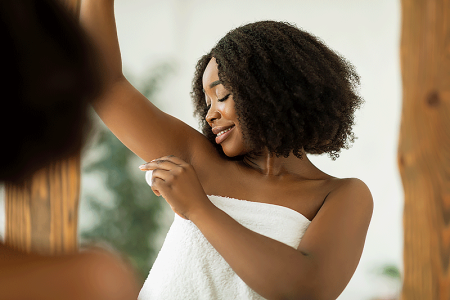Hidradenitis suppurativa: Self-care
Advice that dermatologists give their patients
Patients often ask their dermatologist if they should squeeze hidradenitis suppurativa (HS)
The answer is “no.” Squeezing or popping the nodules, cysts, and sores can injure or irritate your skin. Anything that injures or irritates your skin can worsen HS.

To help their patients who have hidradenitis suppurativa (HS) get the best results from treatment, here’s what dermatologists recommend you do at home:
Wash your skin with an antimicrobial wash. This helps reduce bacteria on your skin. When there's less bacteria, you may have fewer flare-ups.
One product that can decrease the bacteria on your skin is an acne wash that contains benzoyl peroxide or zinc pyrithione.Quit scrubbing your skin. Patients often think that having HS means they have dirty skin. You don’t have dirty skin. If you’re scrubbing your skin to get it clean, stop. Scrubbing causes inflammation, which can worsen HS.
Take care when shaving or waxing skin with HS. In general, dermatologists recommend that patients with HS never wax. Waxing can irritate the skin, which may cause more HS.
If you shave, take extra precautions to avoid nicks and cuts, which could cause a new HS sore or an infection. Here are the precautions that dermatologists recommend:- Before you shave, wash the area with an antibacterial soap.
- Soften and protect your skin by applying a gel-to-foam shaving gel.
- Shave carefully.
Consider laser hair removal as a way to remove hair where you have HS. Studies have shown that getting laser hair removal can reduce flare-ups of HS. Laser treatment can be effective because it reduces the number of hair follicles you have, decreases bacteria on your skin, and makes sebaceous glands less active.
While laser hair removal may sound appealing, it’s important to know that it can be costly. Insurance doesn’t cover the cost, so you’ll need to pay for this treatment.
If you and your dermatologist decide that laser hair removal is right for you, you’d see a dermatologist who performs this procedure. Dermatologists perform laser hair removal during an office visit. The dermatologist who performs the laser hair removal can tell you how many sessions you’ll need. Sessions are generally spaced about 6 weeks apart. It can take time to get the desired results.Treat a painful lump at home with heat. To use heat on HS, dermatologists recommend one of the following methods:
- Black tea compress: To make this compress, place a teabag of black tea in a cup. Pour boiling water over the teabag, and let it seep for 10 minutes until the water is warm rather than hot.
Place a clean, soft cloth or gauze into a clean container and pour the tea over the cloth or gauze. You now have a black tea compress. Wring out the excess liquid and place the compress on the painful HS.
Keep the compress on the HS for 10 minutes. Repeat several times a day as needed to reduce the pain. - Warm water compress: To make this compress, place a clean washcloth under warm running water. Wring out the excess water and place the washcloth on the painful lump. Leave the washcloth on the area for 10 minutes.
You can repeat this several times during the day to reduce pain. This warm compress can also help drain painful HS.
- Black tea compress: To make this compress, place a teabag of black tea in a cup. Pour boiling water over the teabag, and let it seep for 10 minutes until the water is warm rather than hot.
Avoid sweating and overheating. While applying heat to a painful lump can bring relief, sweating and overheating tend to worsen HS. To reduce sweating, dermatologists recommend that you:
- Limit your activity when you’re in a warm or hot place, including the outdoors.
- Stay in a cool indoor space. If that’s not possible, cool down in an air-conditioned place whenever possible.
- In warm weather, try to be outdoors in the morning or late afternoon when it’s cooler.
Use a mild and effective antiperspirant or deodorant. Some products are too harsh for skin with HS. Look for an antiperspirant or deodorant that does NOT contain alcohol, baking soda, parabens, dyes, or fragrance. These ingredients can irritate the skin and cause HS to flare.
An effective antiperspirant or deodorant can prevent worsening HS in the underarm area
If cannot find an antiperspirant or deodorant that keeps you dry without irritating your skin, ask your dermatologist to recommend one.

If you have a wound-care treatment plan, follow it. If HS has caused wounds, your dermatologist will create a treatment plan to help heal wounds and prevent infection.
Wounds can be difficult to treat. Tell your dermatologist if any wound fails to heal, opens up after healing, or becomes more painful.Wear looser clothing if your HS flares when you wear tight or form-fitting clothes. When clothing rubs on skin with HS, it can irritate your skin, causing HS to worsen. If you need to wear tight-fitting athletic clothing or leggings, ask your dermatologist for advice on how to reduce flare-ups.
Tell your dermatologist if you have joint pain. People living with HS have a higher risk of developing diseases that affect the joints like arthritis.
Lifestyle changes can have long-lasting effects
Patients who quit smoking or lose extra weight can have fewer HS flare-ups (and sometimes get rid of) hidradenitis suppurativa.

If you are overweight, lose weight. For many patients who are overweight and have HS, losing weight can reduce flare-ups and prevent HS from worsening. In some studies, patients who lost weight saw their HS go away.
Losing weight has additional benefits for anyone who has HS. Studies show that people with HS have a higher risk of developing heart disease and diabetes. Losing weight and eating a healthy, well-balanced diet can reduce your risk of developing these and other diseases.
If you’re having trouble losing weight, ask your dermatologist or primary care doctor about programs that can help you.If you smoke, stop smoking. Quitting smoking can help you live a longer, healthier life. It can also reduce HS flare-ups and prevent HS from worsening.
Occasionally, patients who stop smoking get rid of their HS.
For many people, quitting smoking is difficult. The cravings for nicotine can be intense. To help people quit, the American Lung Association (ALA) has been offering a quit smoking program for more than 35 years. Today, the ALA says that it’s ranked as one of the most effective programs for helping people quit smoking for good.
Learn more at Freedom from Smoking®.
Your dermatologist can give you specific tips
While these self-care tips can help, HS may affect your skin in different ways. By working one-on-one with a board-certified dermatologist, you can find what works best for you.
Related AAD resources
More resources
Image
Getty Images
References
Alikhan A, Sayed C, et al. “North American clinical management guidelines for hidradenitis suppurativa: A publication from the United States and Canadian Hidradenitis Suppurativa Foundations Part I: Diagnosis, evaluation, and the use of complementary and procedural management.” J Am Acad Dermatol 2019;81:76-90.
Alikhan A, Sayed C, et al. “North American clinical management guidelines for hidradenitis suppurativa: A publication from the United States and Canadian Hidradenitis Suppurativa Foundations Part II: Topical, intralesional, and systemic medical management.” J Am Acad Dermatol 2019;81:91-101.
Carrington AE, Vatanchi M, et al. “Laser hair reduction for hidradenitis suppurativa warrants insurance coverage.” Dermatol Online J. 2020 Apr 15;26(4): 13030.
Narla S, Price KN, et al. “Proceeding report of the fourth Symposium on Hidradenitis Suppurativa Advances (SHSA) 2019.” J Am Acad Dermatol (2020: [epub ahead of print] doi:10.1016/ j.jaad.2020.05.114.
Written by:
Paula Ludmann, MS
Reviewed by:
Shani Francis, MD, MBA, FAAD
Elena Hawryluk, MD, PhD, FAAD
William Warren Kwan, MD, FAAD
Last updated: 5/3/22
 Atopic dermatitis: More FDA-approved treatments
Atopic dermatitis: More FDA-approved treatments
 Biosimilars: 14 FAQs
Biosimilars: 14 FAQs
 How to trim your nails
How to trim your nails
 Relieve uncontrollably itchy skin
Relieve uncontrollably itchy skin
 Fade dark spots
Fade dark spots
 Untreatable razor bumps or acne?
Untreatable razor bumps or acne?
 Tattoo removal
Tattoo removal
 Scar treatment
Scar treatment
 Free materials to help raise skin cancer awareness
Free materials to help raise skin cancer awareness
 Dermatologist-approved lesson plans, activities you can use
Dermatologist-approved lesson plans, activities you can use
 Find a Dermatologist
Find a Dermatologist
 What is a dermatologist?
What is a dermatologist?

